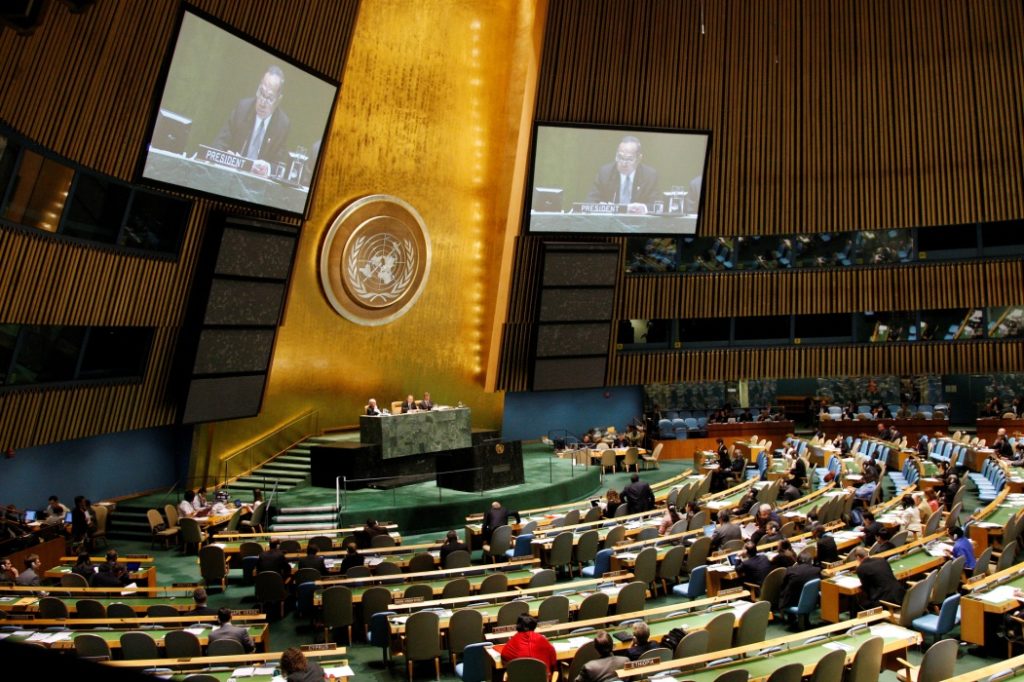This year is the 45th anniversary of the entry into force of the Nuclear Nonproliferation Treaty (NPT), on March 5, 1970. It also marks the approach of the treaty’s latest Review Conference (RevCon)—a once-every-five-years meeting that will take place at the United Nations in New York from April 27 to May 22.
The NPT aims to prevent the spread of nuclear weapons and nuclear weapons technology while working toward complete nuclear disarmament. Its negotiation was a complex feat requiring years of work and substantial compromises on many fronts. The resulting treaty was an historic accomplishment, eventually garnering near-universal membership of the world’s nations, and still stands as the keystone of the international arms control and nonproliferation regime.
More states have ratified the NPT than any other arms control agreement—only India, Israel, and Pakistan have never signed, and North Korea is the only state to have withdrawn from the treaty, in 2003. Over the past 45 years, the NPT has played a central role in ensuring that the number of states possessing nuclear weapons has remained largely stable, rather than jumping to include dozens, as was feared in early years of the nuclear age.
President Obama and other U.S. officials recently acknowledged and celebrated the anniversary of the treaty’s entry into force and its achievements, but the upcoming RevCon may be a less happy occasion for them. Countries without nuclear weapons are growing increasingly impatient as the United States and Russia drag their feet on further nuclear reductions but spend hundreds of billions on modernizing their arsenals, keeping them viable for many decades to come.
The upcoming RevCon is an important opportunity to address that impatience. As one of the two states that possess roughly 95 percent of the world’s nuclear weapons (Russia is the other), the United States could play a pivotal role in ensuring a positive outcome, but so far it has chosen to be cautious rather than ambitious. This is unfortunate, since President Obama showed a strong dedication to the issue early in his term, famously committing to “seek the peace and security of a world without nuclear weapons” in a speech in Prague in 2009. A look back at the founding of the NPT shows why it is important that the United States take advantage of this year’s RevCon to make real progress toward this ultimate goal.

The 2010 NPT Review Conference raised hopes for substantive steps on disarmament, but progress has been largely stalled ever since, and expectations for the 2015 RevCon are less optimistic. (Source: UN Photo/Eskinder Debebe)
The Founding of the NPT
Under the terms of the NPT, the 190 countries in the treaty are divided into two categories: nuclear weapon states and non-nuclear weapon states. The nuclear weapon states—the United States, Russia, China, France, and the United Kingdom—were the first five countries to develop and test nuclear weapons, and all possessed such weapons before they signed the treaty. The fundamental bargain on which the NPT rests is stated in Article VI of the treaty: non-nuclear weapon states agree not to develop or acquire nuclear weapons in exchange for a commitment from the nuclear weapon states to “pursue negotiations in good faith on effective measures relating to cessation of the nuclear arms race at an early date and to nuclear disarmament, and on a treaty on general and complete disarmament under strict and effective international control.”
That is, the NPT’s two-tier structure, with its split between the nuclear “haves” and “have-nots,” is based on the requirement that this situation be only temporary, and that the nuclear weapon states work toward getting rid of these weapons completely.
Originally, the NPT had a twenty-five year time limit, with a provision for the parties to meet every five years to review its operation. In 1995—the last year of that initial period—the parties agreed to extend the treaty indefinitely, and instituted a policy of convening a Review Conference every five years. The indefinite extension was won based in part on a promise to negotiate a Comprehensive Test Ban Treaty (CTBT) to ban forever underground full-scale nuclear testing. In 1996 the international community agreed to such a treaty, but the U.S. Senate rejected it when President Clinton submitted it for ratification in 1999. Given the current political climate it is unlikely to be brought up again during the remainder of the Obama administration, despite officials’ repeated statements of support for it.
The NPT Today
The last NPT RevCon, in 2010, was a moment of hope after the 2005 gathering failed to reach a final agreement. Following on the heels of President Obama’s 2009 Prague speech and the ratification of the U.S.-Russia New START agreement, delegates at the 2010 conference adopted by consensus a 64 point “action plan” to outline a path forward in each of the main areas covered in the NPT—disarmament, nonproliferation, and peaceful uses of nuclear energy.
One part of this plan states that the nuclear weapon states “commit to undertake further efforts to reduce and ultimately eliminate all types of nuclear weapons, deployed and non-deployed, including through unilateral, bilateral, regional and multilateral measures.” Another part entails their commitment to “accelerate concrete progress on the steps leading to nuclear disarmament” which include, among others, rapid cuts in the global stockpile, further diminishing the role and significance of nuclear weapons in security policy and doctrine, and reducing the risk of accidental use.
Despite these commitments, progress has been largely stalled. The United States has offered to negotiate further reductions with Russia, but President Putin has linked any such talks to an array of complicated issues, halting progress. Ominous Russian nuclear threats and deployments of U.S. nuclear-capable bombers to Europe and South Korea have highlighted the role that nuclear weapon states continue to attribute to nuclear weapons. While the nuclear weapon states have organized meetings among themselves as part of a “P5 process” begun in 2009, these sessions have produced little. Meanwhile, the nuclear weapon states continue to spend billions maintaining and upgrading their nuclear arsenals to ensure that they will be effective for decades to come, with no sign that they anticipate eliminating them in the foreseeable future.
In the wake of all this, the upcoming RevCon is widely expected to be particularly contentious. The idea of disarmament seems far less realistic than it did five years ago. Many non-nuclear weapon states are growing impatient and seeking new avenues for progress.
One sign of this is a new focus on the humanitarian effects of nuclear weapons—an effort by nonnuclear weapon states to emphasize that, even if possession of these weapons is restricted to only a few countries, the effects of their use cannot be. A December 2014 conference in Vienna was the most recent of three conferences in the past two years to focus on this problem. Each year attendance has grown, and this year the United States sent a representative for the first time, but it and the United Kingdom were the only nuclear weapon states to do so.
If the nuclear weapon states do not make appreciable progress soon, more and more non-nuclear weapon states are prepared to take action outside the NPT. In particular, many countries are calling for a treaty to ban nuclear weapons, similar to conventions that currently ban chemical and biological weapons. This initiative has gained support from more than 150 NPT members, all of them nonnuclear weapon states. The nuclear weapon states, on the other hand, prefer to remain within the NPT framework, claiming that they are still working toward fulfilling their obligations, but that it will take time.
Looking Ahead
One question, therefore, is what the nuclear weapon states—in particular the United States—can and should do in advance of the upcoming review conference to ensure its success. One possibility, raised by a number of states at the Vienna conference, as well as at last year’s NPT preparatory committee meeting and the U.N. Committee on Disarmament and International Security, is to work toward reducing the alert level of nuclear forces, thereby reducing the risk of accidental, unauthorized, or mistaken use. Accelerating progress in this area was one of the action items agreed at the 2010 RevCon.
As a first step, President Obama could order U.S. ground-based intercontinental ballistic missiles taken off hair-trigger alert, ensuring that they could no longer be launched within minutes. This would immediately decrease the risks posed by these weapons and could encourage Russia to take similar steps.
There are other actions the United States could take as well—with or without reciprocation by Russia. These include further reducing its deployed strategic forces to 1,000 warheads, canceling the proposed new nuclear-armed cruise missile, and declaring that the sole purpose of U.S. nuclear weapons is to deter a nuclear attack on the United States and its allies. These proposals are laid out in more detail in a series of blog posts by my colleague, Stephen Young.
As it stands, without a willing partner in Russia, the United States has been unwilling to lead. As a result, at the RevCon the United States may largely rest on its limited laurels, including the notable but modest progress that it has made in securing nuclear materials. It is unlikely that this will play well with the majority of the delegates at the RevCon, many of whom already believe that the United States and the other nuclear weapon states neglect its call for disarmament. With so much at stake, the United States can – and should – do better.
